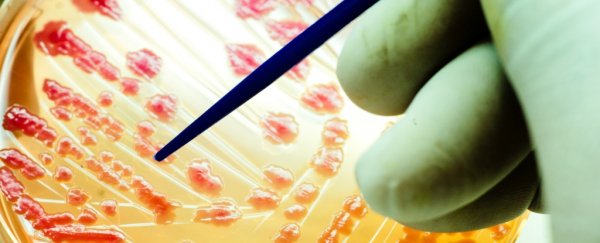Antibiotic resistance is one of the most pressing and underrated issues of the 21st century – some scientists put it on par with climate change, with a 2014 report suggesting that failing antibiotics will kill 300 million people by 2050.
Now Australian researchers are trying to change the way we track and respond to antibiotic resistance, so scientists can respond quicker and more efficiently when our existing drugs fail.
"What we are proposing is a method that measures the underlying problem and gives a quantifiable solution that can be used to see if measures to control [antimicrobial resistance] are working," said Carolyn Michael from the University of Technology Sydney Faculty of Science (UTS Science).
Bacteria and other microbes have very quick life cycles, and a number of ways to pass genes between each other.
This means that whenever we find a new antibiotic to kill off bacteria, they quickly evolve ways of getting around it and can then pass on these new genes rapidly, spreading the resistance further.
Right now, the way that we investigate antibiotic resistance is to look at the number of microbial infections at any one time that aren't responding to antibiotics.
But Michael and her team suspect this is not the most efficient way of approaching the problem.
"Monitoring the crisis is largely limited to counting increasing numbers of resistant pathogens. Rather than monitoring pathogens we are proposing monitoring resistance genes that exist throughout the microbial world and not just in pathogens," she says.
"Doing this will let us see rising numbers of resistance genes before they get to a pathogen and also keep an eye on the different types of resistance genes already in pathogens."
Instead, the team wants to investigate all bacteria types - even those that don't affect us - because the resistance genes in any type of bacteria can be passed onto a microbe that does, via a process called horizontal gene transfer.
This would mean monitoring the resistance genes in bacteria from our sewage, hospitals, and surrounding environments, to understand which resistance genes in the area are currently evolving, and which could potentially become a problem.
"The World Health Organisation recognises this is an up-and-coming crisis. What we are providing is a framework for prediction before [antimicrobial resistance] reaches threshold levels in certain areas," says team member, Ashley Franks, from La Trobe University.
The researchers think this approach would allow clinicians and health authorities to know which antibacterial compounds would be most effective, and when other compounds should be 'rested', so they can be used again down the track.
"I've spent a lot of time in clinical settings and I know doctors are frustrated that they have no way of knowing how long the antimicrobials that they rely on to cure their patients will continue to work," says Michael.
"Global health authorities also need a way to see if their attempts to reduce [antimicrobial resistance] are working before a newly untreatable disease strikes. What we are proposing is a global protocol that both defines and measures the size of the problem and so offers solutions to handle this critical issue."
Considering more and more microbial infections are becoming resistant to whatever antibiotics we try, it's great to see a different approach.
The research has been published in Open Biology.
UTS Science is a sponsor of ScienceAlert. Find out more about their research.
